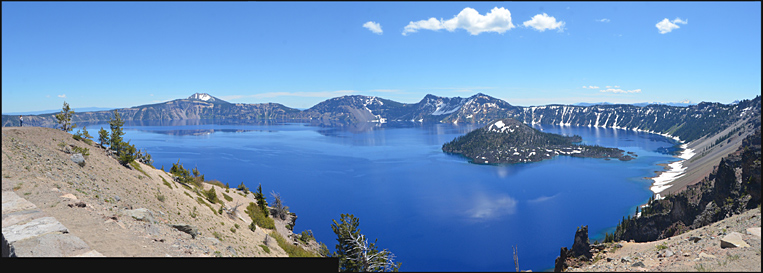
It's Oregon's only National Park. Just a single day spent driving through the Park will stay with you for years. The image below remembers an early fall day when the cold clouds were scudding by, dappling the landscape with warm sunshine despite a very chilling wind. There was a spotlight effect as the sun and shadows raced around the caldera of ancient Mt. Mazama, at one time perhaps the tallest mountain peak in Oregon, now smashed, opened wide, converted from fire into the abobe of 2,000 foot deep crystal waters. It's a high mountain skyscape with a mirror below of amazing azure blue..... Crater Lake, in my book it ranks as one of the wonders of Planet Earth. In the panorama below note the tiny person on the far left side. We're standing at about 7,600 ft. on the western rim of the Lake. Wizard Island is prominent. I highly recommend taking the launch ride around the Lake, and take the boat which drops you off at Wizard Island and lets you explore for a few hours. It's a unique experience. In the picture, note the person in blue pants standing on the far left

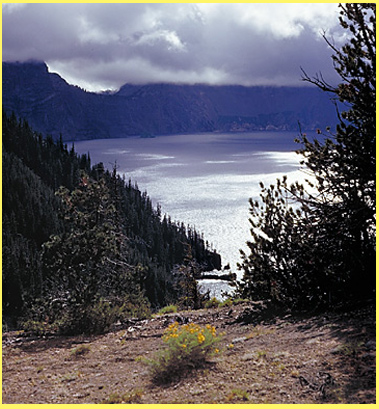
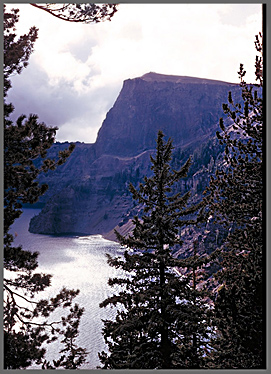
Basic Facts about Crater Lake-- its surface lies at 6,400 feet elevation, while its Rim generally runs between 7,000 and 8,000 feet. The highest point is Mt. Scott on the eastern edge of the Lake, rising to just under 9,000 feet (see image at page bottom to see Mt. Scott).... The 35-mile long Rim Drive around the lake is so deeply buried every winter by snow that it is a challenge to plow it open in time for Fourth of July travellers! The lake is 5 miles across and nearly 2,000 feet deep at its deepest point. Wizard Island is a large cinder cone island in the SW corner of the lake. Cleetwood Cove on the north side of the lake is the only place where tourists can hike down to the lake's shore. There is a gorgeous recently-renovated classic mountain lodge on the south Rim, in the area known as Rim Village. This area is the only place on the lake that one can usually drive to in the winter. (Crater Lake Lodge)
"I patrolled the shores west of
Crater Lake's Cleetwood Cove for an hour, searching for a spot,
any safe spot where one might dive into the Lake, but the 1,500
ft. high cliffs were so steep that I was near to giving up when
I found my diving spot. It met my requirements: an accessible
platform only a couple feet above the Lake, and with the requisite
near-vertical drop-off into deep water to aim myself at. 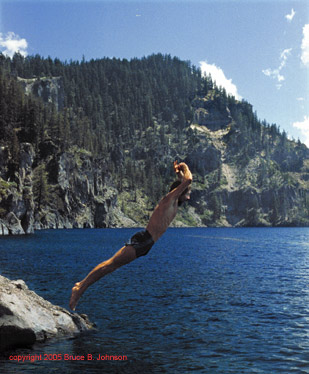 I didn't want any
chance of hitting underwater rocks, and that's all there is along
Crater's plunging shore-- rocks, not soft mud, no weeds, no sand,
nothing but that phenomenal water, crystal pure, like looking
through glass all the way down to maybe 50 feet deep, but then
the eerie shadings of ever-deeper blue swiftly increasing as one's
eye sweeps away from the shore... I tossed a very large flattened,
light color rock as far out as I could get it from a perch 10
feet above the lake. It hit with a normal big splash, and then
I watched in a fascination turning to horror as it fell into the
depths, rocking and swaying, seeming to flash as its whiteness
would catch the light, but rapidly shrinking until, just before
it winked out, it hit the side of the steep underwater cliff,
bouncing downward as a dot, then gone forever. The Rangers say
you can see to nearly 300 feet deep in Crater's water (*see note),
and I remembered the map of the Lake bottom, realizing that it
was only a half mile away to the Lake's deepest point, a stygian
1,932 feet. There I was, a college boy, poised to dive in like
that rock. How cold is that water? My skin registered a hot sun,
that hot high altitude sun that belies that the air is probably
not even 70 degrees. I recalled reading that the Lake waters seldom
freeze in the winter, but never warm above about 38 degrees in
the summer. I tried to form my body into the perfect diving pose,
breathed a huge breath and launched myself. Hitting the water,
I was pleasantly surprised for a second, the water felt far warmer
than 38 degrees, but then I was beneath the thermocline and the
cold hit me like a body wrap of ice cubes, and I was pointed straight
down into the bottomless! Not quickly enough, my momentum killed,
and I kicked ferociously upward, away from the deep blue void
below. My skin welcomed the seeming warmth of the upper layer
of the water, and I worked to float high enough in it so that
my feet didn't sink back into the iciness below. The shore was
close, but a panic thought crossed my mind-- Reality, that maybe
the cliff was too steep, that I would be unable to scale it and
regain the warm land before hypothermia sunk me like a stone.
I kicked harder yet, and my fingers touched cold rock, and in
a blur they rose up to grab warm rock. Then my feet banged rocks,
and it hurt, but I ignored the hurt and thrust myself out of the
unfriendly waters. My entire skin was taut and fiery with the
cold that had gripped it. I rushed to my camera to check that
its self-timer had snapped my dive. The hot sun gradually seemed
to burn my pre-dive personality back to life, and I dressed, and
clambered along the cliffs until I was able to step back onto
the Cleetwood Trail, trying my best to inconspiculously mingle
with the hot, dusty crowds who would never know my secret tasting
of the waters."
I didn't want any
chance of hitting underwater rocks, and that's all there is along
Crater's plunging shore-- rocks, not soft mud, no weeds, no sand,
nothing but that phenomenal water, crystal pure, like looking
through glass all the way down to maybe 50 feet deep, but then
the eerie shadings of ever-deeper blue swiftly increasing as one's
eye sweeps away from the shore... I tossed a very large flattened,
light color rock as far out as I could get it from a perch 10
feet above the lake. It hit with a normal big splash, and then
I watched in a fascination turning to horror as it fell into the
depths, rocking and swaying, seeming to flash as its whiteness
would catch the light, but rapidly shrinking until, just before
it winked out, it hit the side of the steep underwater cliff,
bouncing downward as a dot, then gone forever. The Rangers say
you can see to nearly 300 feet deep in Crater's water (*see note),
and I remembered the map of the Lake bottom, realizing that it
was only a half mile away to the Lake's deepest point, a stygian
1,932 feet. There I was, a college boy, poised to dive in like
that rock. How cold is that water? My skin registered a hot sun,
that hot high altitude sun that belies that the air is probably
not even 70 degrees. I recalled reading that the Lake waters seldom
freeze in the winter, but never warm above about 38 degrees in
the summer. I tried to form my body into the perfect diving pose,
breathed a huge breath and launched myself. Hitting the water,
I was pleasantly surprised for a second, the water felt far warmer
than 38 degrees, but then I was beneath the thermocline and the
cold hit me like a body wrap of ice cubes, and I was pointed straight
down into the bottomless! Not quickly enough, my momentum killed,
and I kicked ferociously upward, away from the deep blue void
below. My skin welcomed the seeming warmth of the upper layer
of the water, and I worked to float high enough in it so that
my feet didn't sink back into the iciness below. The shore was
close, but a panic thought crossed my mind-- Reality, that maybe
the cliff was too steep, that I would be unable to scale it and
regain the warm land before hypothermia sunk me like a stone.
I kicked harder yet, and my fingers touched cold rock, and in
a blur they rose up to grab warm rock. Then my feet banged rocks,
and it hurt, but I ignored the hurt and thrust myself out of the
unfriendly waters. My entire skin was taut and fiery with the
cold that had gripped it. I rushed to my camera to check that
its self-timer had snapped my dive. The hot sun gradually seemed
to burn my pre-dive personality back to life, and I dressed, and
clambered along the cliffs until I was able to step back onto
the Cleetwood Trail, trying my best to inconspiculously mingle
with the hot, dusty crowds who would never know my secret tasting
of the waters."
* the official method of measuring water clarity is the "Secchi" disk, and it is stated that if you could lower a Secchi disk into absolutely pure water, the theoretical maximum value would be between 70-80 meters (230-262 ft). In real-life measurements, Crater Lake in 1972 was measured at 144 feet, while the clearest water ever actually measured was in the Weddell Sea, Antarctica in 1986 at 260 feet.
Story: Bruce B. Johnson, all rights reserved 2014-2025. Contact: jupiterman47@gmail.com
Below is a wonderful piece by my long-term contributor, writer J.D. Adams of Salem, Oregon.
Reflections On Crater Lake
By J. D. Adams
Oregon is a land sculpted by the volcanic
fury of the Pacific Ring of
Fire. The volcanic eruptions of Mt. Mazama were recorded in the
legends of
Native Americans, who faced clouds of ash that darkened the World
almost
8000 years ago [sic-6600 years]. After a series of spectacular
eruptions, the volcano
collapsed in on itself to form a caldera that filled with water
from
bountiful southern Oregon rain and snowfall, creating the deepest
lake in
North or South America.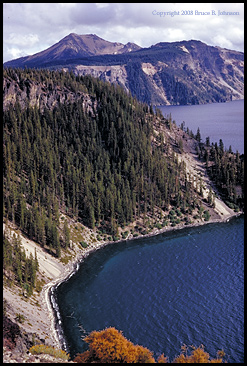
Crater Lake is a mirror of skylight framed in whitebark pine,
glowing
darkly from a cold well of deepest blue. Like a gem of turquoise
in October
country, it lies cradled within high cliffs etched with the fire
of an
ancient cataclysm, silent now except for the sound of windblown
ice crystals
in the trees. After millennium the explosive power remains self-evident,
spellbinding. The mystery of hidden treasure permeates this Indian
legend,
rediscovered by gold miners in 1853.
It is an early October morning, cold and clear, the sun reflects
brightly from recent snowfall, frosting the peaks and ridges around
the rim
of the crater. On these days Crater Lake is at its best, displaying
a royal
blue to fascinated onlookers who started coming before it became
a national
park in 1902. Climbing the last few feet up to our first viewpoint,
my wife
and I stepped into a postcard setting crafted from the essential
elements of
sky, water, and stone. There is a quiet sense of eternity in the
alpine
perfection of Crater Lake, like a legendary place that waits at
the end of a
long journey, mythical and yet real.
We explored the 5-mile wide caldera on Rim Drive, a 33-mile loop
with
numerous viewpoints that brought many shades of blue to Crater
Lake's
pristine water. The mood was festive with an international flavor,
for at
every viewpoint groups huddled in awe and cackled their amazement
in foreign
languages. At Cloudcap Overlook, at nearly 8000 ft., enter a zone
of
rarefied air and extreme exposure, surrounded by sun-bleached
whitebark
pines bent with the force of prevailing storms streaming from
the west. A
few miles southward, Vidae Falls tumbles gracefully from one of
the ridges
that rise nearly 2000 ft. around Crater Lake, creating a rugged
backdrop to
its profound blueness. Moving west past Crater Lake Lodge, the
dormant cone
of Wizard Island dominates the foreground in a dramatic statement
of
volcanic destruction and renewal. Soon winter snows will close
the North
Park Entrance, and the cross-country skiers will have it all to
themselves.
There is a satisfying sense of completeness in a trip to Crater
Lake,
for it is something every Oregonian should experience at least
once in their
lifetime, if only to appreciate the grand spectrum of our geology.
In the
quiet waters shines the stardust of inspiration, a hypnotic spell
cast by
rippling patterns of sunlight in a looking-glass of blue.
j1mcm0s@earthlink.net
Copyright 2006-2024, All Rights Reserved